Artificial Insemination Programs for Cattle
Use of Artificial Insemination
Artificial insemination (AI) is the most widely used assisted reproductive technology. Although AI is much more widely used in dairy herds than beef herds, it is becoming more important in beef cattle breeding programs. The labor required for AI is the most common reason beef cattle producers do not use this technology. However, exhaustive economic analysis of AI shows it increases net revenue in most situations. Refer to MSU Extension Publication 2486 Economic Impact of Artificial Insemination vs. Natural Mating for Beef Cattle Herds for more detail on the economics of AI.
The primary reason for implementing AI is to gain access to sire genetics that would be too expensive to get from a live bull. For example, a cattle producer in Mississippi can use a bull valued at more than $100,000 for approximately $20 per dose. Furthermore, that bull might be located many miles away and not readily available for live cover. This also amplifies the number of calves that bull can sire in a given year—from 30 to 60 calves to thousands. This rapidly increases the accuracy of genetic predictions on a given sire and “proves” his genetics sooner. Some seedstock operations use AI to include reference sires in their calf crops to compare natural service herd sires against.
Artificial insemination can also reduce the number of bulls required, and associated bull maintenance costs, required for a single-cow herd. Semen can be stored and used from infertile, injured, or dead animals. Owners of valuable bulls may decide to collect semen from them as an insurance policy against animal infertility, injury, or death. AI can also eliminate the introduction of sexually transmitted diseases from infected bulls.
Artificial Insemination Defined
Artificial insemination is the process of collecting sperm cells from a bull and manually introducing them into the reproductive tract of a cow or heifer. In commercial application, this also involves extending one collection of semen into several doses and freezing it in liquid nitrogen to be stored indefinitely and/or shipped. A more recent development is the ability to sort sperm cells into fractions that will yield primarily either heifer or bull calves. MSU Extension Publication 2569 Sex-Sorted Semen for Beef Cow-Calf Production addresses this topic.
Most commercially available semen is collected using a teaser animal and an artificial vagina that directs the ejaculate into a collection vial. A sample of the collected semen is then evaluated under a microscope for the number of sperm cells and their motility (movement) and morphology (shape) as indications of fertilizing capacity. If the sperm cells in that ejaculate are of a high enough quality to be frozen, the semen is extended into several doses, packaged in straws, and frozen in liquid nitrogen for storage. Before semen straws became the mainstream semen storage unit, semen was packaged in ampules.
Female Reproductive Anatomy
The entire female reproductive tract is a tubal structure with different textures, sizes, and features. The inside hollow portion of that tube is called the lumen. Beginning at the bottom, the external genitalia is referred to as the vulva. The vestibule vagina is the portion of the vagina behind where the urinary bladder empties in through the urethra. From there is the anterior vagina. The two sections of the vagina are different in their environment and function.
After the anterior vagina is the cervix. The cervix is one of the most prominent features of the female reproductive tract and is often referred to as the “landmark” because it is relatively easy to identify from the other tissues when palpating the tract via the rectum of cows and heifers.
Beyond the cervix is the uterus. There is the body of the uterus, and then the uterus splits (internal or external uterine bifurcation). From that split, the uterus takes the shape of two ram’s horns, where it gets the name uterine horn. The bovine uterus is bicornuate (two-horned) with moderately developed uterine horns. The horn narrows at the end and becomes a small tube called the oviduct. The ovary is located at the end of the oviduct. The ovary houses the ovum (eggs) that will eventually be released into the oviduct to be fertilized.
When a heifer is born, its ovary contains all the eggs it will ever have. They do not replicate, and the ovary is never replenished. That means when a calf is born to a 13-year-old cow, the oocyte (egg) it developed from was dormant in that cow and remained viable since before the cow was born. The importance of realizing this is to know that those ovum can, in severe cases, become damaged, and fertility can be permanently affected.
Various structures grow and regress on the ovary. As a structure grows, it does not move around the surface of the ovary but remains in the spot where it began to develop. The follicle begins as a small group of cells organized around the oocyte. When it receives the right hormone signals, the cells multiply and the follicle begins to grow. Eventually, those cells produce fluids that fill the inside of the follicle, and it appears as a blister on the surface of the ovary (Figure 1).

After the cow comes into heat (estrus), the follicle ruptures and expels the oocyte. When this happens, the remaining tissue turns into another structure called the corpus luteum (CL) (Figure 2). The CL eventually regresses and lets another follicle develop and ovulate. Some of these events occur simultaneously and on both ovaries. Each structure produces different hormones. The follicle produces estrogen. The CL produces progesterone.

The oviduct is made up of three distinct sections: infundibulum, ampulla, and isthmus. The infundibulum acts as a funnel that wraps around the ovary to catch the oocyte when it is released. It moves the oocyte into the ampulla where small projections sweep it toward the center of the oviduct. The isthmus joins at the center to create the ampullary-isthmus junction. Fertilization always occurs at this junction because, if sperm cells were deposited at the right time, they will be waiting there after having been swept up from the uterus.
The uterine interior layers are made of smooth muscle that is important for expelling the fetus at the end of pregnancy. The bumps on the inside wall are called caruncles. These are the actual points where the placenta will attach to the uterus for transfer of nutrients from the dam’s blood to the fetus and waste from the fetus to the dam’s blood.
The next major feature moving down the reproductive tract is the cervix. The major role of the cervix is to create a physical barrier between the uterus and the outside environment that will protect the developing fetus. The tissue that makes up the cervix is very dynamic and can change from a dense and rigid structure to a loose and flaccid structure that expands to allow a full-term fetus to pass through. For most of a cow’s life, the cervix is rigid and has interlocking folds, often referred to as “rings” (Figure 3), with a thick mucus in the lumen. When the cow becomes sexually receptive (in heat), the cervical tissue relaxes and the mucus becomes thinner. This allows semen and sperm cells to move through to the uterus on their way to the oviduct.

In AI, the semen has been extended and must be deposited in the uterus rather than in the vagina where it would be deposited during natural mating. To do this, it is loaded in a long slender insemination rod (also called an insemination pipette or gun) that is manually passed through the cervix. The opening of the cervix protrudes back into the vagina. The fornix vagina is a 360-degree blind fold around the cervical entrance that frustrates many beginner AI technicians (Figure 4). It creates the false sensation that an insemination rod is inside the cervix when it is actually in this blind pocket.
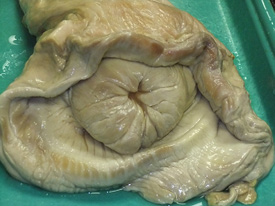
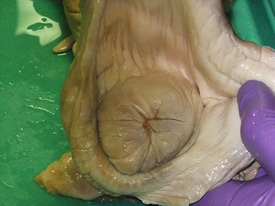
The vagina spans from the cervix to vulva and is comprised of two distinct sections. The sections are differentiated by where the urethra, which drains the urinary bladder, enters. The environment of the posterior vagina is not hospitable to sperm cells so, in natural mating, semen is usually deposited in the anterior vagina. The urethra is another important consideration that relates to AI. When entering the vagina, always angle the insemination rod upward to avoid inserting it into the urethra.
Management Considerations
The most basic description of reproduction in cattle is as follows. Semen is deposited in the vagina when the female is in heat. Sperm cells in that semen are moved to the oviduct. In the meantime, an oocyte is released from the ovary and also moves to the oviduct. When the sperm and oocyte meet, fertilization occurs and produces an embryo. The embryo moves from the oviduct into the uterus, where it develops into a fetus and is gestated for the remainder of the pregnancy. After the fetus reaches full term, it is expelled (parturition or calving). There are many things that must happen at the appropriate timing for successful AI. It requires excellent herd reproductive management, semen handling, and insemination technique.
Heat Detection and Synchronization
The added requirements for implementing AI are increased labor and training in heat detection and semen handling and deposition. Heat detection is often the most limiting factor in an AI program. Proper timing of insemination depends largely on effective heat detection and is critical to achieve high conception rates. Detailed information on heat detection is in MSU Extension Publication 2610 Estrus (Heat) Detection in Cattle.
A working knowledge of estrous synchronization is also valuable for most AI programs. Because of the challenge of heat detection, estrous synchronization protocols involving a fixed-time insemination have been developed. Information on estrous synchronization appears in MSU Extension Publication 2614 Estrous Synchronization in Cattle. Estrous synchronization protocols specify the appropriate timing of heat detection and insemination.
In the absence of using an estrous synchronization protocol, many producers rely on the “AM/PM rule” to decide when to AI cattle. According to this rule, females first observed in heat in the morning should be inseminated that evening. Similarly, females first observed in heat in the evening should be bred the next morning. Proper heat detection is important when using the AM/PM rule. Timing insemination as close to 12 hours after females first show heat is important when using this rule. Waiting until the next day to breed a female observed in heat in the morning is too late for good results.
AI Supplies and Equipment
Supplies and equipment needed or useful for AI programs include these:
- bull semen
- semen storage tank
- liquid nitrogen
- electronic thawing device or insulated water bath
- thermometer
- timer
- straw-cutting device
- insemination rod
- plastic sheaths
- plastic obstetrical sleeves
- obstetrical lubricant
- paper towels
- record-keeping supplies
- cattle handling facilities (including breeding box or squeeze chute with head catch and palpation cage and protection from weather)
Semen Storage
Semen must be stored at temperatures below -112°F at all times. Semen can be permanently damaged by even very short exposures to elevated temperatures. By maintaining storage conditions of consistently very low temperatures, bull semen can be stored indefinitely.
Semen storage tanks are large vacuum-sealed metal bottles (Figure 5). They are extremely well-insulated. These tanks can maintain internal temperatures of -320°F (liquid nitrogen temperature) as long as they contain at least 2 inches of liquid nitrogen.

The amount of time that a semen storage tank can hold adequate quantities of liquid nitrogen before needing to be refilled varies. Many older tank models must be refilled every 6 to 8 weeks. Newer, more technically advanced tanks may have nitrogen holding times as long as 6 to 9 months. It is critical to schedule timely nitrogen fills to maintain both semen and tank integrity. Make sure the nitrogen is refreshed before transferring semen to the tank. Tank nitrogen supplies may also need refreshing after extensive use from insemination sessions.
Keep semen storage tanks in locations where they can be viewed daily. Make sure that tanks lids are secured, and closely monitor the amount of liquid nitrogen. Flexible plastic measuring sticks are available for this purpose. Wooden yardsticks may also be used to determine nitrogen depth in the bottom of a tank.
Frost or sweat on the outside of the tank (often at the neck and vacuum fitting) indicates that tank vacuum insulation has been lost. Liquid nitrogen evaporates rapidly when this occurs. In this situation, semen must be transferred to a good tank immediately before nitrogen amounts drop too low to maintain acceptable semen storage temperatures. Semen in tanks that have gone dry is likely not viable and should be evaluated before use or discarded.
To protect the tank from corrosion, keep it elevated above concrete or wet floors. Boards and pallets work well for this. Store tanks in sheltered areas away from blowing rain, winds, drafts, and direct sunlight. Drafts can cause excessive nitrogen evaporation. However, adequate ventilation is important for preventing possible suffocation of people or animals caused by breathing excessive nitrogen gas in the air. Make sure tanks are safe from tampering by children or vandals.
Semen Thawing and Handling Technique
Warm-water thawing of semen straws generally takes 30–60 seconds. Thawing recommendations vary by semen processor. When possible, use the thawing recommendations from the AI organization that processed the semen. In cases where semen from multiple processors is used, decide on one thawing procedure to use. The National Association of Animal Breeders recommends thawing semen in 90 to 95°F water for at least 40 seconds. Time the thaw with a watch or timer instead of guessing the time elapsed.
Electronic thawing devices are convenient to use (Figure 6). An electricity source at the site of semen handling is needed for these units. When functioning properly, these devices keep the water temperature between 95 and 98°F. Be sure to check the accuracy of these devices periodically with a reference thermometer, and adjust or replace equipment as needed.
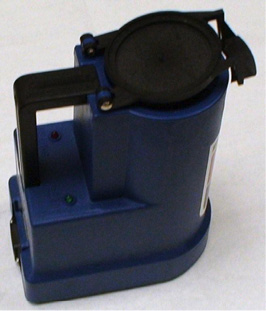
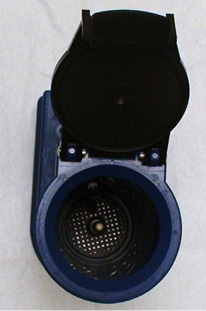
Proper semen handling before, during, and after the thawing process is critical to protect sperm viability. Cold shock is a major concern with use of warm-water thawing. If semen is thawed and then exposed to cold environmental temperatures before reaching the cow or heifer, it can cause permanent injury to sperm. The rate and span of temperature drop determines the severity of damage from cold shock.
Good semen storage records including canister numbers and cane codes are essential. A flashlight can be used to read cane codes (Figure 7) without having to lift semen canes out of the liquid nitrogen. Identify the location of the semen straw in the storage tank before thawing or moving it to another tank. Update semen inventory records for each tank and canister after transferring semen in or out of a tank.

Move the semen quickly from the semen tank to the thawing unit, from the thawing unit into the AI rod, and then into the animal to be inseminated. From the center position in the tank (Figure 8), raise the desired canister just high enough in the tank neck to grasp the needed cane of semen. Immediately lower the canister to the tank floor. If it takes more than 10 seconds to locate a particular cane, then lower the canister back into the tank to cool completely before trying again. Return the canister to its storage position after semen removal.

When removing a semen straw from a cane, keep the cane as low as possible in the tank. Semen raised above the frost line for even a few seconds can decline in fertility. Work quickly to remove the straw using tweezers instead of bare hands to touch the straws. Plastic tweezers designed to handle semen straws can be used (Figure 9). Take care not to bend or break the straws. If the straw is in the upper goblet of a cane (Figure 10), bend back the top metal tab of the cane to a 45-degree angle to allow for easier straw removal. After the needed semen straws are removed, bend this tab back to its original position so the cane label can be easily read in the tank. Once a straw is removed from the cane, do not return it to the tank.


When transferring semen between tanks, have the tanks side by side and full of nitrogen. With the appropriate canister in the center position in each tank, transfer the canes quickly, within 3 to 5 seconds. Do not touch the semen straws with bare hands in this process.
Thaw only one straw of semen at a time. Gently shake the straw as it is taken from the storage tank to remove any liquid nitrogen retained in the cotton plug end of the straw. Immerse the entire straw in the water bath. After thawing, use a paper towel to dry the straw. Adjust the air space in the straw by gently flicking the wrist while holding the straw at the crimped, sealed end. This helps prevent semen loss when the end of the straw is cut.
When the straw of semen is properly thawed, load it into a clean, dry, warm AI rod (Figure 11). Hold the insemination rod next to the semen handler’s body and under the clothing to warm it before loading the thawed semen and until insertion of the rod into the animal for insemination. Brisk rubbing of the end of the insemination rod with a wrapped paper towel can warm the rod through friction. The rod has a plunger that, when depressed, pushes the semen from the straw (Figure 12). Make sure that this plunger is pulled out of the rod several inches when loading semen and prior to insemination.


Transfer the straw to the rod, and squarely cut the tip of the sealed end of the straw. A special cutting tool is designed for this purpose (Figure 13). Then cover the loaded rod with a clean protective plastic sheath. Do not reuse sheaths. Make sure ahead of the insemination session that the correct sheath design is matched with the rod type to be used (Figure 14). Depending on the rod design, the sheath is secured at the base by either screwing it down in a twisting motion (Figure 15) or pushing it down through a doughnut-shaped retainer. Lastly, wrap the loaded end of the insemination rod with a paper towel, and tuck it inside the inseminator’s clothing for insulation and added warmth. Never place the AI rod in the mouth or carry it uncovered.
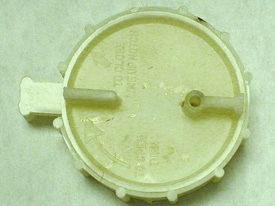
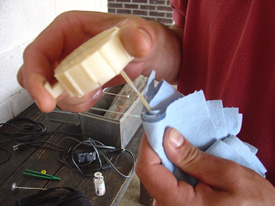
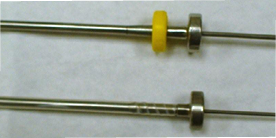
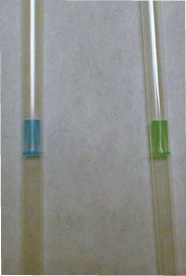

Insemination Technique
Start with proper, low-stress restraint of cattle to be inseminated. Do this before thawing semen. Covered cattle handling facilities are important for protection from weather. Make sure that the shelter extends far enough beyond the semen handling and cattle insemination areas so blowing precipitation will not cause problems.
Breeding boxes specifically designed to accommodate cattle restraint for insemination are available for purchase or can be built on the farm. In the absence of a breeding box, a squeeze chute is important to immobilize the animal for insemination (Figure 16). It allows for animal and inseminator safety as well as ease of insemination. A head catch is useful to prevent the animal from backing up in the squeeze chute. A palpation cage located immediately behind the squeeze chute allows the inseminator access to the back end of the animal while protecting that person from animals lined up in the chute leading up to the palpation cage. It also provides a quick escape route for the inseminator if needed. Good traction in the squeeze chute or breeding box is also important to prevent the cow or heifer from slipping down during the insemination process.
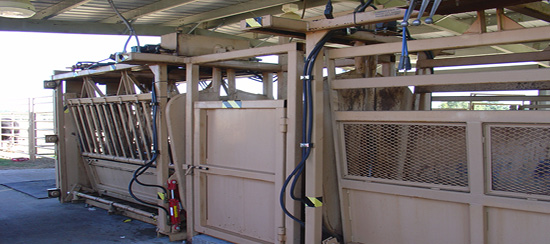
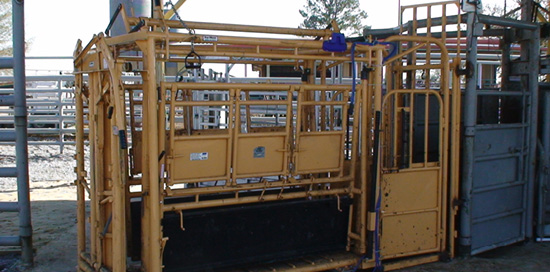
Sanitation is an important part of the recto-vaginal insemination process. Poor sanitation increases risk of metritis (uterine inflammation) and infertility of cattle. Store breeding supplies in original packaging until time for use. Insist that everyone handling AI equipment and semen thoroughly wash their hands to minimize bacteria transfer to cattle being inseminated using these items. Before inserting the insemination rod into the animal, use clean paper towels to wipe manure, mud, and other foreign material from the cow’s vulva and surrounding area. Prevent the insemination rod from becoming soiled prior to insertion.
Wear a plastic obstetrical sleeve on the arm being inserted through the anus (external opening at the end of the digestive tract where feces exit) and into the female’s rectum (terminal part of the large intestine). Secure the open end of the sleeve to clothing at the shoulder with a clip to prevent the sleeve from slipping down during palpation. Turn the sleeve inside-outside to put any abrasive seam edges towards the interior of the sleeve and not in contact with the animal’s rectum. This can help reduce irritation of the rectum during the insemination process. Be generous in obstetrical lubrication use, coating both the rectum and sleeve prior to arm insertion into the animal. However, do not allow lubricant to contact the vulva region, as lubricants are generally spermicidal.
Inseminating technicians may choose to use their less dominant arm and hand for rectal palpation on the premise that touch sensitivity may be better for the fingers of the less dominant side. Less muscle mass in one arm may also help ease arm insertion and lessen muscle tiring during the palpation process. Yet, it is often easier for a technician to use the left arm for rectal palpation to locate and manipulate the reproductive tract. That is because the rumen, the largest compartment of the cow’s or heifer’s digestive tract, is located on the animal’s left side. This slightly displaces the reproductive tract to the animal’s right side. Reaching a left palpating arm towards the right is typically is less awkward than the reverse scenario.
Gently touch the animal on the rump to avoid startling it when approaching for AI. Then insert one sleeved, lubricated arm through the anus and into the cow’s or heifer’s rectum. Cup the hand with the fingers and thumb together during insertion, and gently work the arm into position to locate the cervix from above through the rectal wall. Place the animal’s tail on the outside of the palpating arm to keep it from interfering with insemination, or use a second person to hold the tail out of the way. Another person assisting is particularly useful when an animal exhibits excessive tail movement during AI.
Circular muscle contractions may move along the rectal wall toward the tail. These contractions can be strong and make it difficult to maneuver within the rectum. They also contribute to inseminator arm fatigue. To relax a rectal constriction ring, insert two fingers through the ring center and massage it back and forth. In the event of defecation, keep the palpating hand flat against the floor of the rectum to allow manure to pass over the hand and arm.
Spread the lips (folds) of the cow’s or heifer’s vulva apart by placing a clean, folded paper towel into the lower portion of the vulva if working alone or have another person spread the vulva lips. This allows insertion of the insemination rod into the vagina without contacting the vulva lips. Insert the loaded insemination rod into the vagina at a slight (30 to 40 degree) upward angle taking care not to enter the urethra and bladder. Straighten the rod to a more level position once about 6 to 8 inches inside the vagina.
Locate and secure the cervix with the hand used in the rectal palpation. It is sometimes described as feeling like a “turkey neck” with several hard circular rings and can vary greatly in width and length from animal to animal. In some cattle, the cervix has more crooks or bends than others. Straighten any vaginal folds by grasping the cervix and pushing it forward.
Where the cervix joins the front end of the vagina, there is a circular blind pouch approximately ½ to 1 inch deep. Make sure to the rod enters the cervical opening instead of this blind pouch. Back the rod up as needed if this obstacle is encountered. Place the cervix over the rod, and do not jab or force the rod. Gently maneuver the rod through the folds of the cervix by manipulating the cervix slightly ahead of the rod while maintaining slight forward pressure on the rod. Once through the cervix successfully, the tip of the rod can be felt with a finger placed at the far opening of the cervix.
Depress the insemination rod plunger slowly to deposit the semen into the animal. Deposit the semen over a period of about 5 seconds in the body of the uterus to ensure that semen flows evenly into both uterine horns. Deposit semen just in front of the cervix rather than in the vagina or cervix. Make sure the rod tip is only ¼ inch past the internal end of the cervix. The proper deposition location is very important in AI because the number of sperm in a single dose of semen is greatly reduced when a single ejaculate is extended. Normally, when the bull deposits an ejaculate in the cow’s vagina, the semen volume is 4 to 5 cc and there are 1 to 1.5 billion sperm per cc. The normal volume of frozen semen in the U.S. is 0.5 cc with a total of 30 to 40 million sperm. Many of these sperm die before reaching the oviduct, so giving them a “head start” through the cervix greatly improves conception rates.
Cervical mucous could be encountered in females previously inseminated. The presence of this mucous may indicate that the female is pregnant. Cervical mucous feels thick and sticky on the insemination rod. If it is encountered, deposit the semen halfway through the cervix.
Take care not to inadvertently block a uterine horn or otherwise misdirect semen flow with the palpating hand during semen deposition. Do not pull the insemination rod back through the cervix until after semen deposition is complete. If the cow or heifer moves during semen deposition or if the rod moves, stop the deposition. Then correctly reposition the rod tip and continue semen deposition.
Inseminate the female within 15 minutes or less from the time the semen is removed from the storage tank. Insemination generally takes from 30 seconds to 2 minutes for a proficient inseminator. After insemination, briefly stimulate the female’s clitoris via gentle squeezing motions at the base of the vulva. This may improve conception rates.
Although one person can perform record keeping, semen handling, and insemination duties, use more than one person for these tasks when possible. This allows each person to concentrate on the task at hand and to assist the others when needed. It also allows inseminators to take shifts to prevent excessive tiring of arm muscles from the palpation process.
The information given here is for educational purposes only. References to commercial products, trade names, or suppliers are made with the understanding that no endorsement is implied and that no discrimination against other products or suppliers is intended.
Publication 2628 (POD-12-21)
Reviewed by Brandi Karisch, PhD, Associate Extension/Research Professor, Animal and Dairy Sciences. Written by Jane A. Parish, PhD, Professor and Head, North Mississippi Research and Extension Center, and Jamie E. Larson, PhD, Interim Assistant Director and Professor, Animal and Dairy Sciences.
The Mississippi State University Extension Service is working to ensure all web content is accessible to all users. If you need assistance accessing any of our content, please email the webteam or call 662-325-2262.






